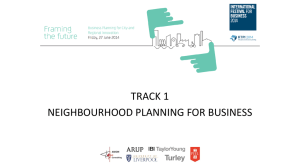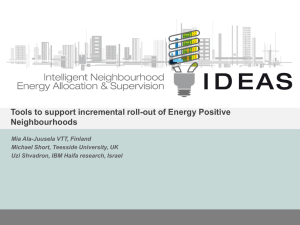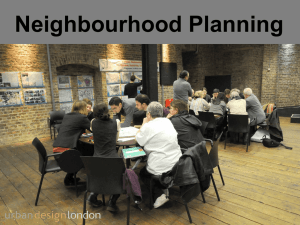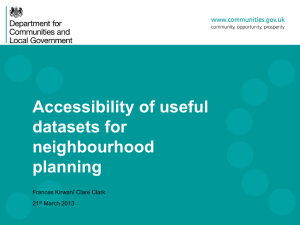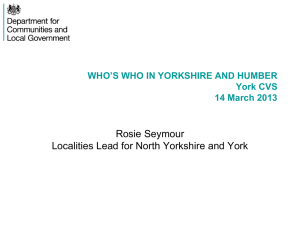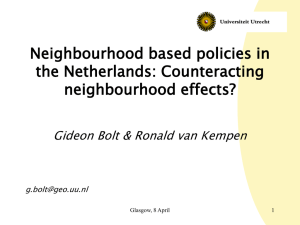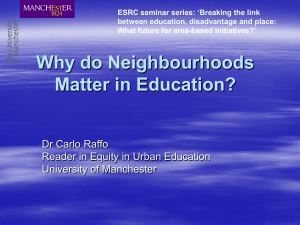Presentation - Neighbourhood Effects
advertisement
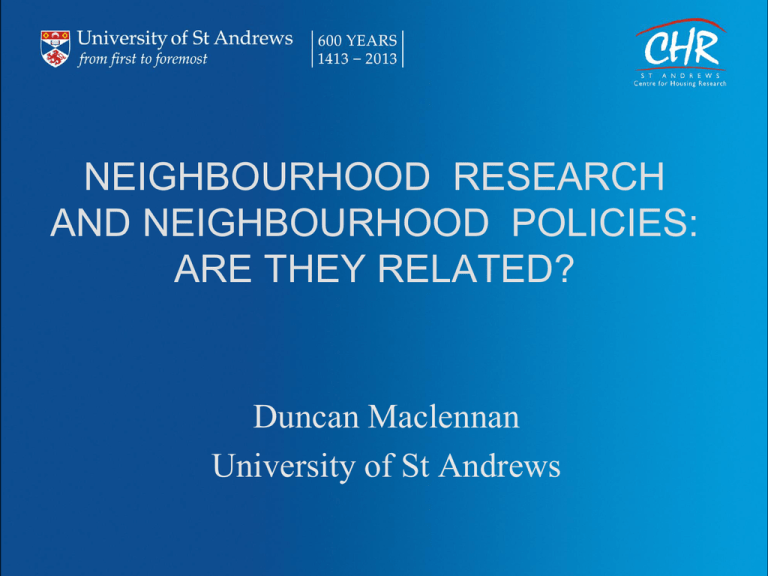
NEIGHBOURHOOD RESEARCH AND NEIGHBOURHOOD POLICIES: ARE THEY RELATED? Duncan Maclennan University of St Andrews OUTLINE 1. KEY QUESTIONS, ARGUMENTS 2. 3. 4. 5. 6. THEORETICAL QUESTIONS ON NEIGHBOURHOODS, EMPIRICAL EVIDENCE IN PRINCIPLE POLICY INTERESTS POLICY-MAKING REALITIES: UK AND OTHER EXPERIENCES WHAT DOES THIS SAY ABOUT RESEARCH IMPACTS ON POLICY FUTURE RESEARCH ISSSUES 1. MY QUESTIONS. PRIORS. IS THERE EVIDENCE ON NE IS IT EMPIRICAL, QUAL, EVAL,EXPERIENTIAL WILL IT IMPACT POLICY (existence, design?) PAPER HAS RESEARCH IMPROVED? HAS POLICY EXPANDED, IMPROVED HAVE IDEAS LED POLICY CAN WE EXPECT, MEASURE RESEARCH IMPACT 2. REVEALING, REFRESHING NEIGHBOURHOOD IDEAS Perspective: applied economics, real pol/econ. Understandings greatly improved in last two decades for NEIGHBOURHOODS • Multiple Function Field Definition – Fuzzy field definitions ( Galster, HAPs) – Multiple scales (Suttles) – Different typologies of places • • Perceptual differences (Downs and Stea) Joint choices with property (home) choice – Meanings of home, n’hood (Mallet, Forrest) • Constraints in choice, selection effects (social too) 2. NEIGHBOURHOOD COMPLEXITIES, CAPABILITIES • Multiple Attributes (Lancaster, Quigley, Galster) – Properties, living and working spaces – Proximities; neighbours, facilities and wider city – Public service provision, costs and governance – Perceived Image, status, reputation – Patterns of Interactions • Involving neighbour contact, Impersonal spillovers • Priced and not priced (externalities) – Capabilities, institutions of places (resilience) (SEN) ATTRIBUTES AS LASTING FORM OF CAPITAL, TIME MATTERS AS MUCH AS SPACE 2. NEIGHBOURHOODS: TIME • • • Expectations: of values, interactions? Endogenous dynamic: ageing, repair Exogenous dynamic – Steady-state equilibrium (classic Filtering models) – Dynamic Equilibrium OR RE STUDIED NEIGHBOURHOODS – Unanticipated shocks – Complex, partly-open systems with non-linear change – Thresholds, cusps, multiple equilibria (Schelling) I ASSUME LATTER, PERVASIVE AND LARGELY IGNORED IN MODELLING, POLICY AND EVALUATION: LIMITS TO ECONOMETRIC AND POLICY UNDERSTANDINGS; REPLICABILITY 2 EVIDENCE? : PLACE, Academic • • • • • • Housing Demand , quality outcomes (UK, no) Residential Attachment (UK, no) Residential/Neighbourhood satisfactions (Yes) Social capital studies (yes, limited, JRF Geographies of disadvantage (Yes, index) Neighbourhood Change (Gentrificat’n, Soc Estate; weak on general patterns of change, drivers; unconvincing theory of change) • Qualitative as much as quantitative research LOCALISED, PARTIAL, WEAK ON ECONOMICS 2. EVIDENCE: Evaluations • • • • • • • Community and housing cost LED literature Partnerships Specific area initiatives, Flagships Specific area projects (Routine) Programme evaluations (SRB, GEAR) etc Conceptual frameworks Never Systematically Reviewed, Positives but Problematic, Do they consider dynamic, random elements in change, how replicible? 2. EVIDENCE: N. Effects, Mixed • • • • • • • Pre school learning School performance Training Behaviour Crime Employment Health Social/Tenure mix Particular People in particular Kinds of Places? Mixed conclusions, more to do. The experiental evidence, the ordinary knowledge of experts, practitioners and politicians 3. TO WHOM DO NEIGHBOURHOOD OUTCOMES CHOICES MATTER? For whom are neighbourhood outcomes a policy issue? • • • • Individuals, quality and choice Outcomes for the neighbourhood, community Outcomes for spatial structure, city systems Wider spillover effects: nation, global HOW DOE WE CATERGORISE POLICY INTERESTS IN NEIGHBOURHOODS 3. POLICY AS POVERTY ALLEVIATION Can be Conceived, Rationalised in different ways 1. REDISTRIBUTIVE Simple sectoral spends – Is this an effective way to alleviate poverty effects? – Does it reduce other expenditure claims (e.g. housing investment reduces health claims) – Is policy aimed at the poorest places? – Are poor spatially concentrated? 3. POLICY AS EFFECTIVE MANAGEMENT AND GOVERNANCE 2. ALLOCATIVE: Public economics of service provision/governance – – – – What are local outcomes desired Does this need conjoined service delivery, locally Does ‘local community’ have service say Are capabilities for resilience, ‘normalcy’ present EFFICIENT SERVICE ORGANISATION, COST, GOVERNANCE 3. POLICY AS PLACE PRODUCTIVITY 3. CREATIVE, space non-neutral, takes longer view • Juxtaposition, proximity synergies (location or accessibility effects, may be traded) – Within the neighbourhood – Relative to other neighbourhoods • Wider externalities (spillover effects, eg environment) • Neighbour Effects (social interaction effects) • Late start to identifying pathways to effects, causal chanins TRANSFORMATIVE EFFECTS CAN YOU ANSWER 1 AND 2 WITHOUT CONSIDERING 3? YES DO NEIGHBOURHOOD EFFECTS MATTER FOR POLICY MAKING? SHOULD THAT INFLUENCE RESEARCH AGENDA? 4. POLICY-MAKING REALITIES AND EVIDENCE ROLES Thinking about place in Policy Has Improved. But does research progress policy, or vice versa? • Always a valid question for some researchers • And for some funders Is it valid as a metric in REF? ESRC What does this presuppose about research to policy innovation system? Incentive • Is not about private profits • Involves, usually, expenditure and distrib shift Policy making may be sometimes evidence influenced but it is rarely evidence based. It is an inherently ethical, political process beset by conflicts and tradeoffs. It involves, usually, Passion as well as Reason. Passion and reason are not always in Equilibrium, Balance differs over space and time. So also do political preferences. The same ‘facts’ or findings give different choices in different settings. 4. UK Policy drives research? US tradition of strong neighbourhood research. In contrast UK • Uses until 2000’s US findings in teaching etc, Scant research on – City structures, factorial ecologies into 1970’s – Inner Cities research into 1980s weak on n’hoods – Rejection of ideas as ‘spatial fetishism’ • Welfare state housing into 1980’s emphasis on units, not places; – BTS and clearance (New Town exception?) – HAA, GIA, silos LEFT UK RESEARCH WEAK ON UNDERSTANDING NEIGHBOURHOODS AND THEIR DYNAMICS 4…..and into 1990’s 1980’s sees start of different thinking (Glasgow) • Gear, UDCs, some better than others • Momentum of CBHA’s (cf England) • Riots in Inner Cities, England BUT POLICY INVERSION, LIMITED TO SPENDING DEPARTMENTS; TREASURY SEES THIS ALL AS DISPLACEMENT, NO PRODUCTIVITY EFFECTS.EVALUATIONS GIVE DIFFERENT SENSE GLOBAL ECONOMY CAPITAL MARKET MACROPOLICY SOCIAL SEC Technology Deregulation LABOUR MARKET Incomes, Jobs, Inequalities HOUSING SYSTEM CITY N'HOOD EFFECTS NEIGHBOURHOODS 4……..and at the start of the major policy expansion… By mid-1990’s • SPI, Scotland, Carley in England • But no coherent theory of change, little evid • Evaluations chart programmes • Social exclusion discussion banned until 1996 • Public admin still in silos as Blair starts; the multiple zones • JRF and ESRC progs postdate major shift; BUT LIMITED EMPIRICAL WORK ON N’HOODS • SEU was critical and Delphi technique, attitudes outweigh data IMAGINATIVE BUT UNRESEARCHED THIRD WAY THINKING PAVED BASIS FOR MAJOR PROGRAMMES. NEIGHBOURHOOD EFFECTS STEMS FROM THIS. PROGS HAD MAJOR FINDINGS INTERNATIONALLY TRANSMITTED VIA WEB ETC BOTTOMS UP : ENDOGENOUS CHANGE EXTERNAL STABILITY. AGILITY CREATIVITY SECTORS CITY PLACE NEIGHBOURHOOD LOCAL EFFECTS SOCIAL CAPITAL EMPOWERS 4. HOW DID EVIDENCE COUNT? Same evidence, sorts of Evidence, in Aus/Can • • • • • • Policy action requires one level with resources Creating national views from below, cf UK Policy and practice innovation inversions Who are research targets, who wants it? Different spatial expertise of top levels Different policy research communities Not simple split politics, bureaucracy to shape take - 4. AN ESSENTIALLY PROCESS POLITICAL Politics is • All parties and parliament, not just govt • Includes politicians, press and policy advisers • Hierarchies of Departments, Ministers – Treasury and PM Office, associated Policy Units – Major versus minor spending ministries (housing versus infrastructure?) DIFFERENT INFORMATION CHANNELS TO THESE ACTORS, HAVE DIFFERENT COSTS AND RISKS, SOME INHERENTLY POLITICAL 4. BUREAUS HAVE OWN OBJECTIVES Within Departments, Status Hierarchy • Minister’s Office, Special Advisers (blocked?) • Department Management Group • Policy Directors • Research Divisions (ESRC Linkage?) STAYING OUT OF THE PRECIPICE OF POLITICS DIFFICULT, FALLING INTO IT RAISES RETURNS AND RISKS OF MAKING AN IMPACT 5. RESEARCH IMPACT, THE REF AND THE ESRC Making an Impact on neighbourhood policy • Research quality helps may be even necessary,never sufficient • The interaction with the bureaucracy, can be helpful, is filtered for convenience, image • Interaction with politics has high returns, more direct, requires better messaging Academics can control the quality, message, range and persistence of communications; impact tests their skill as ‘politicians’ rather than as researchers. HEFCE and ESRC now confusing the two. What strategy for neighbourhood effects research findings? 6. NEIGHBOURHOODS RESEARCH PRIORITIES • NE’s as the Higgs-Boson search in soc science? Too • • • • expensive to do properly, too unclear to message easily What can be messaged? AND NOW The new value of accessibility and proximity The Big Society Localism, and the demise of community and neighbourhood?
